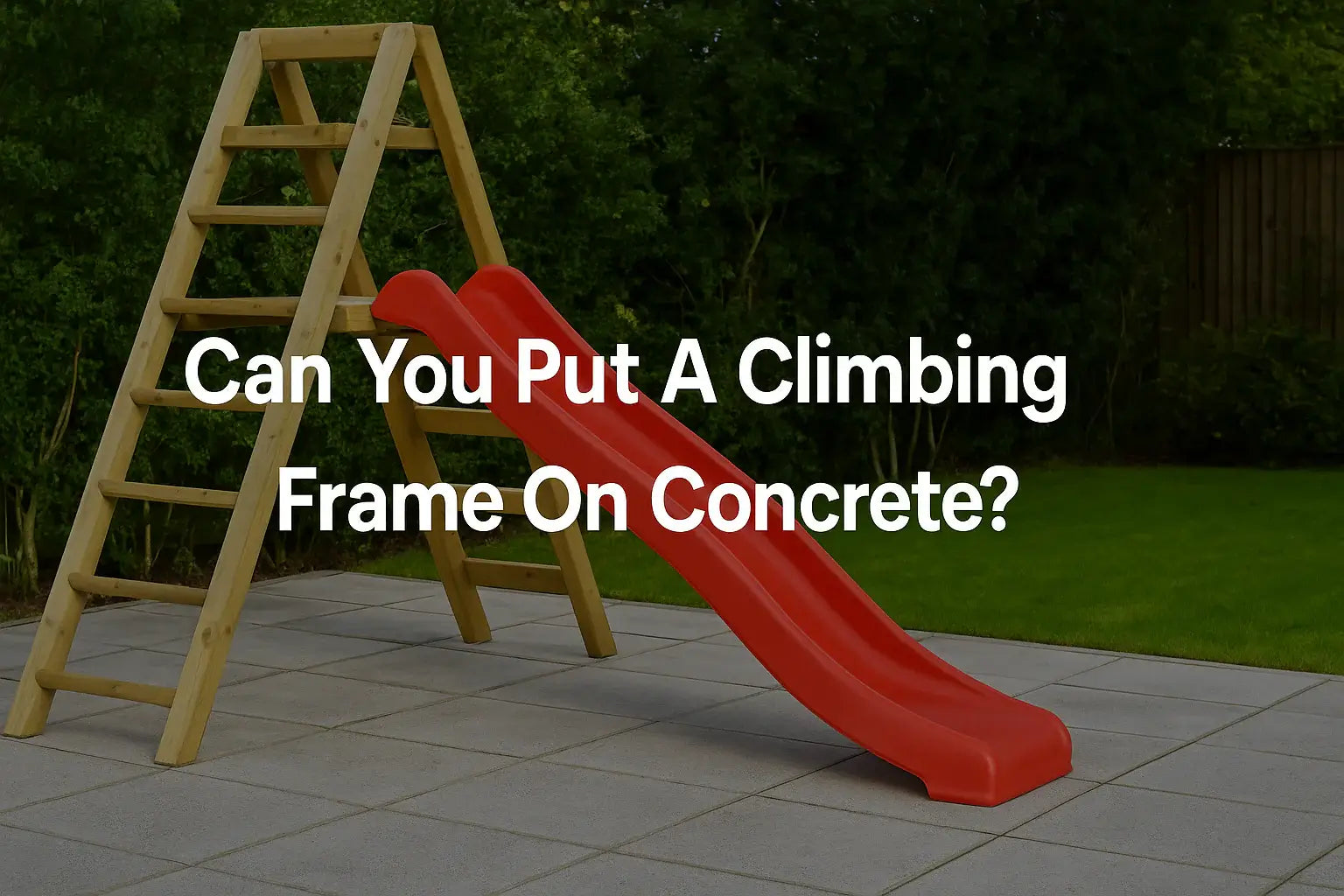
Can You Put A Climbing Frame On Concrete?
Concrete garden? No problem. You can put a garden climbing frame on concrete—safely, too. The secret? Anchors, shock-absorbing surfacing, and a bit of planning.
If you’re wondering how to stop scraped knees and wobbly frames, stick around. We’ll show you how to turn grey slabs into playtime gold.
The Risks of Placing a Climbing Frame Directly on Concrete
High Risk of Serious Injury from Falls
It might look like a strong base—but concrete isn’t kid-friendly. Falls happen. And when they do, landing on a rock-hard surface can lead to serious injuries.
A few bumps and bruises are one thing. But broken bones? That’s not something any parent wants to risk.
Lack of Impact Absorption
Concrete doesn’t cushion. It doesn’t bend or give. Unlike grass or bark, there’s zero softness when little knees hit the deck.
That’s why playgrounds use shock-absorbing surfacing. And it’s not just for looks—it's essential for safety.
Hard, Abrasive Surface Dangers
Aside from the lack of cushioning, concrete is rough. One slip on it, and you’ve got grazes, scrapes, or worse.
Kids are built tough, but elbows and chins still don’t cope well with a hard, gritty landing.
Manufacturer Recommendations and Warnings
Most manufacturers don’t recommend setting up climbing frames directly on hard surfaces like concrete.
Voiding Warranties with Unsuitable Surfaces
In fact, if you ignore their guidelines, you might even void the warranty. No one wants that.
If the structure gets damaged or someone gets hurt, you’re out of pocket and out of options.

Essential Safety Solutions for Concrete Bases
The Critical Need for Protective Surfacing
The solution? Create a safer landing zone around the frame.
Adding shock-absorbing surfacing on top of the concrete is the single most important thing you can do.
Understanding Critical Fall Height (CFH)
Here’s where it gets technical—but stick with us. UK safety standards use something called Critical Fall Height (CFH).
It basically means: how far can a child fall without seriously hurting themselves? The higher the frame, the more padding you need underneath.
Recommended Surfacing Materials for Concrete
So what can you use?
-
Rubber mulch – soft and affordable, but might need topping up
-
Wet pour rubber – smooth, long-lasting, and professional-looking
-
Rubber tiles – easy to install, neat, and low maintenance
Whatever you choose, just make sure it’s suitable for your frame’s fall height.
Achieving Adequate Depth and Coverage
Each material comes with its own depth requirements. For example, loose-fill mulch usually needs 200–300mm to work effectively.
Poured rubber or tiles will vary depending on the equipment. Always double-check your chosen product against safety standards (BS EN 1177 if you’re in the UK).

Anchoring a Climbing Frame to Concrete
Now, let’s talk about keeping the frame still. Anchoring it properly is just as vital as the padding beneath it.
Specialised Concrete Anchors and Bolts
Regular bolts won’t do the job here. You’ll need concrete-specific anchors.
-
Expansion anchors – great for solid concrete (up to 500kg load)
-
Chemical anchors – best for older or weaker slabs (up to 1000kg)
-
Drop-in anchors – ideal for areas that get a lot of use (up to 2000kg)
Ensuring Secure and Stable Fixtures
Make sure everything is level. Double-check each bolt. Give the whole frame a gentle shake before letting the kids near it.
It should feel as solid as a tree trunk.
Professional Installation for Concrete Anchoring
Not keen on drills and resin? Don’t sweat it. A local handyman or installer can get it done in a morning—leaving you with peace of mind and a ready-to-go play space.

Best Practices for a Safe Play Area on Concrete
Preparing the Concrete Surface
You’ve picked your spot. Now it’s time to prep it.
Cleaning and Ensuring a Smooth Base
Look for cracks, old paint, or oil stains. Anything that could interfere with the anchors or adhesives needs to go.
A quick power wash can do wonders. Smooth and clean is the goal here.
Drainage Considerations
Water pooling under the frame? Not good.
Make sure the surface slopes slightly or has decent drainage. This keeps things dry, safe, and stops the surfacing from wearing out too quickly.
Installation of Safety Surfacing
This is where it starts to look like a proper play zone.
Step-by-Step for Rubber Tiles or Wet Pour
-
Clean the concrete
-
Apply primer or adhesive
-
Place your tiles (or pour your rubber)
-
Smooth it out and let it cure
It’s a bit like laying flooring—but outside.
Ensuring Proper Adhesion and Seamlessness
Check for gaps. Seal edges tight. Uneven surfaces can trip little feet—and ruin the look.
A seamless surface is safer and easier to clean.
Ongoing Safety Checks
Installation done? Great. But don’t forget about regular upkeep.
Inspecting Surfacing for Wear and Tear
Over time, you might notice patches wearing thin—especially under swings or high-traffic zones.
Rubber tiles may loosen or mulch may spread. A quick sweep and patch every now and then keeps things safe.
Checking Anchor Security
Give the frame a wobble test every month or so.
Bolts can loosen with use, especially after wild weather or heavy play. Tighten anything that feels off, and keep rust at bay with regular checks.
Final Thought
A climbing frame on concrete? Absolutely doable—with the right know-how.
Just add the right surfacing, anchor it like a pro, and keep an eye on things. Before you know it, you’ve turned the boring bit of the garden into the most exciting place on the block.
Have you checked out our other posts?
Can I Put A Climbing Frame In My Garden?
How High Can A Climbing Frame Be?
Can I Put A Climbing Frame On Artificial Grass?
Do Climbing Frames Need Planning Permission?
Can You Put A Climbing Frame On A Slope?
What Is Best To Put Under A Climbing Frame?



Leave a comment